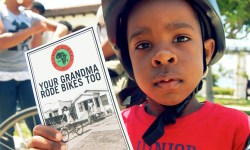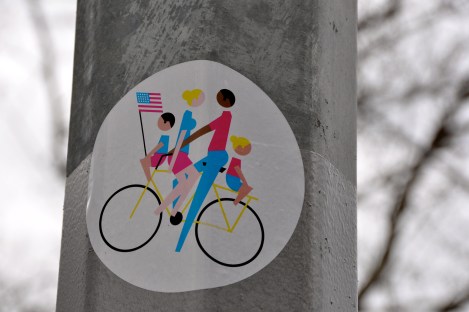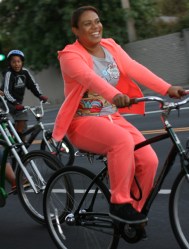Even as it grows in popularity, cycling just can’t shake its reputation as a pastime for spandex- or skinny jean-clad white people. But a new report from the Sierra Club and the League of American Bicyclists challenges that common stereotype, spotlighting a decade of rapid growth in biking among communities of color.
From 2001 to 2009, the percentage of trips taken by bike increased by 50 percent among Latinos, and by 100 percent among African Americans — compared to only a 22-percent increase among whites. This, the report notes, is in spite of the fact that communities of color often lack the kind of infrastructure that makes biking safer, easier, and more appealing. Twenty-six percent of non-whites said they want to ride more but worry about safety (compared to only 19 percent of whites); 47 percent of non-whites said they’d ride more if they had better access to secure places to park and store their bikes (versus 32 percent of white folks).
These safety concerns aren’t unfounded: The report cites data from the Los Angeles County Bicycle Coalition indicating that neighborhoods with the largest share of people of color have lower distributions of bike facilities, and that the lowest-income neighborhoods have the most bike and pedestrian crashes. Those neighborhoods have the most to gain from an increase in cycling: The nation’s poorest families spend the biggest chunk of their income on transportation — 30 percent. The average yearly cost of owning and operating a bike is only $308, compared to $8,220 for an average car.
Simple infrastructure upgrades can have major impacts on riding habits, says the report:
In New Orleans, the installation of a bike lane on South Carrollton Street dramatically increased the number of diverse riders, including a 135% growth in youth, 115% rise in female and 51% increase in African American bicyclists.

Red, Bike & GreenA participant in a Red, Bike & Green family ride.
As traditionally underrepresented cyclists grow in number, groups supporting them are increasingly popping up and pushing for bike-friendly policy changes. The report highlights how organizations like Oakland-founded Red, Bike & Green, L.A.’s Multicultural Communities for Mobility, and Chicago’s Girls Bike Club can give marginalized cyclists a political voice and a support system, both of which are critical for increasing ridership. In Atlanta, for example, local groups rose up against the city’s failure to include Black neighborhoods in its distribution of bike lanes, and successfully petitioned planners to reconsider their designs and refocus funding. And 36 percent of people of color (compared to just 21 percent of whites) say an active riding club would encourage them to bike more.
That need for solidarity is what prompted Jenna Burton to found Red, Bike & Green:
Even in the bike-friendly Bay Area, a black cyclist was a bit of an aberration. This led Burton to start an all-black cycling group, simply because “I wanted other black people to be just as excited about bike riding as I was.”
It’s a simple goal that makes for an effective strategy. The report found African Americans twice as likely as whites to agree that they’d have a better perception of cyclists if they represented a “broader cross section of Americans, such as women, youth and people of color.”
That’s just the change we see happening. And if we want the cycling population to more closely reflect the changing demographics of this country — the women, youth, and people of color leading us into the future — it’s essential that this healthy, sustainable, and cheap transportation option become more accessible and appealing even to those who wouldn’t be caught dead in spandex.

kellanDoes this mysterious sticker represent the family vehicle of the future?




